|
|
|
Sort Order |
|
|
|
Items / Page
|
|
|
|
|
|
|
| Srl | Item |
| 1 |
ID:
093469


|
|
|
|
|
| Publication |
2010.
|
| Summary/Abstract |
The implementation of climate policies in the US and EU in light of uncertainties about future international climate policy has shifted attention to two interrelated concerns, namely competitiveness and carbon leakage. Although various policy measures are available to address these concerns, there has been much discussion about one such measure in particular: the use of offsetting measures at the border. This article compares policy discussions in the US and the EU on how to address competitiveness and carbon leakage concerns, with a focus on the role of import-related border adjustment measures. It analyses the kinds of measures that so far have been put forward with a view to addressing competitiveness and carbon leakage; compares the approaches to the problems in the US and the EU; and provides a preliminary discussion of international cooperation on border adjustment measures. It concludes that two kinds of cooperation are needed between the EU and the US - not only cooperation through formal international negotiations, but also cooperation through international learning processes, in which the EU and the US learn from each other about design and implementation issues as they develop their respective cap-and-trade systems.
|
|
|
|
|
|
|
|
|
|
|
|
|
|
|
|
| 2 |
ID:
093516


|
|
|
|
|
| Publication |
2010.
|
| Summary/Abstract |
The Chinese government has enacted policies to promote alternative vehicle fuels (AVFs) and alternative fuel vehicles (AFVs), including city bus fleets. The life cycle (LC), energy savings (ES) and GHG reduction (GR) profiles of AVFs/AFVs are critical to those policy decisions. The well-to-wheels module of the Tsinghua-CA3EM model is employed to investigate actual performance data. Compared with conventional buses, AFVs offer differences in performance in terms of both ES and GR. Only half of the AFVs analyzed demonstrate dual benefits. However, all non-oil/gas pathways can substitute oil/gas with coal. Current policies seek to promote technology improvements and market creation initiatives within the guiding framework of national-level diversification and district-level uniformity. Combined with their actual LC behavior and in keeping with near- and long-term strategies, integrated policies should seek to (1) apply hybrid electric technology to diesel buses; (2) encourage NG/LPG buses in gas-abundant cities; (3) promote commercialize electric buses or plug-in capable vehicles through battery technology innovation; (4) support fuel cell buses and hydrogen technology R&D for future potential applications; and (5) conduct further research on boosting vehicle fuel efficiency, applying low-carbon transportation technologies, and addressing all resultant implications of coal-based transportation solutions to human health and natural resources.
|
|
|
|
|
|
|
|
|
|
|
|
|
|
|
|
| 3 |
ID:
093475


|
|
|
|
|
| Publication |
2010.
|
| Summary/Abstract |
Water deficits and their associated shortages are serious problems in many areas of the world. The paper presents a multi-criteria analysis for selection of the most suitable system in Mauritania. Six scenarios, different energy sources, technologies of water desalination processes and water use and five criteria are analyzed. The multi-criteria analysis shows that the optimal solution is different for each scenario; in some cases the photovoltaic-reverse osmosis option is preferable; in others, the best option is reverse-osmosis powered by wind energy or concentrating solar parabolic.
|
|
|
|
|
|
|
|
|
|
|
|
|
|
|
|
| 4 |
ID:
093523
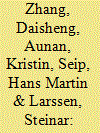

|
|
|
|
|
| Publication |
2010.
|
| Summary/Abstract |
We establish the link between energy use, air pollution, and public health impacts in Taiyuan for 2000, and for 2010 and 2015 under alternative scenarios. We find that in year 2000 more than 2200 excess deaths may have been caused by particulate matter (PM) pollution. Using alternative methods for monetization of health impacts the total health damage amounts to 0.8-1.7 billion Yuan, which is 2.4-4.9% of the city's GDP in 2000. Compared to the business-as-usual scenario, scenarios assuming extensive fuel switch in low-and-medium-stack pollution sources and extension of the district heating system could prevent 200-1100 PM10-related premature deaths in 2010 and substantially reduce population morbidity. The actual PM pollution in 2007 was lower than modeled in these two scenarios. We also find that if air quality in urban Taiyuan were to reach the Chinese National Grade II Standard in 2015, the number of premature deaths would still be around 1330 and the economic cost about 1-2% of the city's GDP in 2015. Our results imply that there are large health benefits to be gained by setting stricter standards for the future in China, and that targeting low-and-medium-stack source effectively reduces health damage.
|
|
|
|
|
|
|
|
|
|
|
|
|
|
|
|
| 5 |
ID:
093537
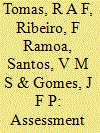

|
|
|
|
|
| Publication |
2010.
|
| Summary/Abstract |
This paper describes an assessment of the impact of the enforcement of the European carbon dioxide (CO2) emissions trading scheme on the Portuguese chemical industry, based on cost structure, CO2 emissions, electricity consumption and allocated allowances data from a survey to four Portuguese representative units of the chemical industry sector, and considering scenarios that allow the estimation of increases on both direct and indirect production costs. These estimated cost increases were also compared with similar data from other European Industries, found in the references and with conclusions from simulation studies. Thus, it was possible to ascertain the impact of buying extra CO2 emission permits, which could be considered as limited. It was also found that this impact is somewhat lower than the impacts for other industrial sectors.
|
|
|
|
|
|
|
|
|
|
|
|
|
|
|
|
| 6 |
ID:
093468


|
|
|
|
|
| Publication |
2010.
|
| Summary/Abstract |
Beyond the different approaches to set regulated prices for the use of infrastructure, a key parameter to determine regulated tariffs is the concept of asset life and how it changes with changes in the economic and regulatory context, which determines the optimal infrastructure investment and replacement policies. In this paper we look at the effects that changes in demand, the presence of substitutes and complements, the regulatory framework - both a pro or an anticompetitive framework - , scale economies, and the investment planning horizon, have on the economic service life of an asset and the tariffs for its use. We find that as the electric industry becomes more competitive, a negative effect on the economic service life of electric electricity transmission should be expected. Also, numerical experiments illustrate an inverse relation between scale economies on investment and the ESL of electricity transmission infrastructure. Further, we look at the biases on optimal investment that happen when optimal plans do not observe the life cycle of the investments and the ESL of the equipment, as well as the inconsistency and biases on optimal investment and replacement policies that might result when the Social Planner optimal investment plan lacks of a long-term commitment.
|
|
|
|
|
|
|
|
|
|
|
|
|
|
|
|
| 7 |
ID:
093477
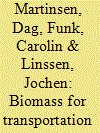

|
|
|
|
|
| Publication |
2010.
|
| Summary/Abstract |
The introduction of biofuels from biomass for transport purposes in an energy system model shows that bioethanol and vegetable oil can compete with oil products without subsidies provided prices of imported energy carriers are high, i.e. crude oil prices around $ 100/bbl. About half of the biomass will be used for motor fuel substitutes, whose share of the final energy in the transportation sector will increase to 10% in 2030. This gives rise to a nearly 9% drop in CO2 emissions in the transportation sector as compared to an emission balance where all real local emissions are fully counted. Despite a strong enhancement of biomass and biomass fuels and quite high prices for oil and gas up to 2030, BtL products like synthetic gasoline and diesel from biomass do not play an important part in the model results unless fairly high penalties are set for CO2 emissions. In the case of global CO2 penalties below Euro 300/tco2 the use of biomass will even shift away from vehicle fuel production to biomass power plants and CHP. A CO2 penalty above Euro 100/tco2 in the transportation sector only, will, however, trigger the production of liquids and synthesis gases from biomass for use as BtL.
|
|
|
|
|
|
|
|
|
|
|
|
|
|
|
|
| 8 |
ID:
093481
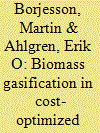

|
|
|
|
|
| Publication |
2010.
|
| Summary/Abstract |
Biomass integrated gasification combined cycle (BIGCC) plants could, in combined heat and power (CHP) generation, increase the power-to-heat ratio compared to conventional biomass steam turbine plants. Furthermore, biomass gasification could also be used for the efficient production of biofuels for transport. In this study, different applications of biomass gasification in connection to district heating (DH) are analysed and contrasted to conventional technology options. An application of the cost-optimizing energy system model MARKAL with a detailed description of the DH sector in a southwestern region of Sweden was developed within the study and used in the analysis. Policy measures for CO2 reduction and for promotion of "green" electricity are assumed, and required subsidy levels for large-scale production of transport biofuels are calculated. The model also operates with different supplies of biomass: a local supply at a lower cost and an international supply of refined biomass at a slightly higher cost. The study shows that investments in BIGCC CHP are often cost-efficient in cases with low ambitions regarding transport biofuels. However, due to limitations in heat demand and in local, lower cost, supply of biomass, investment in biofuel production means less investment in BIGCC CHP and, thereby, a smaller electricity production.
|
|
|
|
|
|
|
|
|
|
|
|
|
|
|
|
| 9 |
ID:
093487


|
|
|
|
|
| Publication |
2010.
|
| Summary/Abstract |
The last 20 years efforts to find a long-term and large-scale biofuel alternative to petrol and diesel for the transport sector have been intensified with a focus on liquid biofuels, such as ethanol, methanol and Fischer-Tropsh diesel derived from wood. The large-scale production of biomethane has so far largely been overlooked in comparative studies that focus on the long-term renewable options. The aim of this article fills this gap and to provide a broad and systematic assessment of the future potential of biomethane compared to other biofuels. In order to become a large-scale option, biomethane production from woody biomass via gasification needs to be developed and commercialized. However, biomethane exhibits a clear development path with relatively low financial and technical risks starting with local solutions utilizing wet biomass resources towards medium and eventually large-scale gasification with economics similar to liquid second generation biofuels. The disadvantage of being a gaseous fuel is not insurmountable and can furthermore be relaxed by the integration and dual-use of the existing distribution system for natural gas. This assessment concludes that more emphasize should be given to biomethane as a large-scale option given the opportunity to use woody biomass from gasification.
|
|
|
|
|
|
|
|
|
|
|
|
|
|
|
|
| 10 |
ID:
093502


|
|
|
|
|
| Publication |
2010.
|
| Summary/Abstract |
Methanol production from biomass is a promising carbon neutral fuel, well suited for use in fuel cell vehicles (FCVs), as transportation fuel and as chemical building block. The concept used in this study incorporates an innovative Absorption Enhanced Reforming (AER) gasification process, which enables an efficient conversion of biomass into a hydrogen-rich gas (syngas) and then, uses the Mitsubishi methanol converter (superconverter) for methanol synthesis. Technical and economic prospects for production of methanol have been evaluated. The methanol plants described have a biomass input between 10 and 2000 MWth. The economy of the methanol production plants is very dependent on the production capacity and large-scale facilities are required to benefit from economies of scale. However, large-scale plants are likely to have higher transportation costs per unit biomass transported as a result of longer transportation distances. Analyses show that lower unit investment costs accompanying increased production scale outweighs the cost for transporting larger quantities of biomass. The unit cost of methanol production mostly depends on the capital investments. The total unit cost of methanol is found to decrease from about 10.66 R/l for a 10 MWth to about 6.44 R/l for a 60 MWth and 3.95 R/l for a 400 MWth methanol plant. The unit costs stabilise (a near flat profile was observed) for plant sizes between 400 and 2000 MWth, but the unit cost do however continue to decrease to about 2.89 R/l for a 2000 MWth plant. Long term cost reduction mainly resides in technological learning and large-scale production. Therefore, technology development towards large-scale technology that takes into account sustainable biomass production could be a better choice due to economic reasons.
|
|
|
|
|
|
|
|
|
|
|
|
|
|
|
|
| 11 |
ID:
093470


|
|
|
|
|
| Publication |
2010.
|
| Summary/Abstract |
This paper attempts to examine the dynamic relationship between economic growth, nuclear energy consumption, labor and capital for India for the period 1969-2006. Applying the bounds test approach to cointegration developed by Pesaran et al. (2001)we find that there was a short- and a long-run relationship between nuclear energy consumption and economic growth. Using four long-run estimators we also found that nuclear energy consumption has a positive and a statistically significant impact on India's economic growth. Further, applying the Toda and Yamamoto (1995)approach to Granger causality and the variance decomposition approach developed by Pesaran and Shin (1998) we found a positive and a significant uni-directional causality running from nuclear energy consumption to economic growth without feedback. This implies that economic growth in India is dependent on nuclear energy consumption where a decrease in nuclear energy consumption may lead to a decrease in real income. For a fast growing energy-dependent economy this may have far-reaching implications for economic growth. India's economic growth can be frustrated if energy conservation measures are undertaken without due regard to the negative impact they have on economic growth.
|
|
|
|
|
|
|
|
|
|
|
|
|
|
|
|
| 12 |
ID:
093547
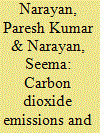

|
|
|
|
|
| Publication |
2010.
|
| Summary/Abstract |
In this paper we test the Environment Kuznet's Curve (EKC) hypothesis for 43 developing countries. We suggest examining the EKC hypothesis based on the short- and long-run income elasticities; that is, if the long-run income elasticity is smaller than the short-run income elasticity then it is evident that a country has reduced carbon dioxide emissions as its income has increased. Our empirical analysis based on individual countries suggests that Jordan, Iraq, Kuwait, Yemen, Qatar, the UAE, Argentina, Mexico, Venezuela, Algeria, Kenya, Nigeria, Congo, Ghana, and South Africa-approximately 35 per cent of the sample-carbon dioxide emissions have fallen over the long run; that is, as these economies have grown emissions have fallen since the long-run income elasticity is smaller than the short-run elasticity. We also examine the EKC hypothesis for panels of countries constructed on the basis of regional location using the panel cointegration and the panel long-run estimation techniques. We find that only for the Middle Eastern and South Asian panels, the income elasticity in the long run is smaller than the short run, implying that carbon dioxide emission has fallen with a rise in income.
|
|
|
|
|
|
|
|
|
|
|
|
|
|
|
|
| 13 |
ID:
093471


|
|
|
|
|
| Publication |
2010.
|
| Summary/Abstract |
China now faces the three hard truths of thirsting for more oil, relying heavily on coal, and ranking first in global carbon dioxide (CO2) emissions. Given these truths, two key questions must be addressed to develop a low-carbon economy: how to use coal in a carbon-constrained future? How to increase domestic oil supply to enhance energy security? Carbon Capture and Storage (CCS) may be a technological solution that can deal with today's energy and environmental needs while enabling China to move closer to a low-carbon energy future. This paper has been developed to propose a possible CCS roadmap for China. To develop the roadmap, we first explore major carbon capture opportunities in China and then identify critical CCS-enabling technologies, as well as analyze their current status and future prospects. We find that coal gasification or polygeneration in combination with CCS could be a nearly unbeatable combination for China's low-carbon future. Even without CCS, gasification offers many benefits: once coal is gasified into syngas, it can be used for many different purposes including for alternative fuels production, thereby increasing the domestic oil supply and the flexibility of the energy system.
|
|
|
|
|
|
|
|
|
|
|
|
|
|
|
|
| 14 |
ID:
093506


|
|
|
|
|
| Publication |
2010.
|
| Summary/Abstract |
The globalization of trade has numerous environmental implications. Trade creates a mechanism for consumers to shift environmental pollution associated with their consumption to other countries. Carbon leakage exerts great influences on international trade and economy. Applying an input-output approach, the paper estimates the amount of carbon dioxide (CO2) embodied in China's foreign trade during 1997-2007. It is found that 10.03-26.54% of China's annual CO2 emissions are produced during the manufacture of export goods destined for foreign consumers, while the CO2 emissions embodied in China's imports accounted for only 4.40% (1997) and 9.05% (2007) of that. We also estimate that the rest of world avoided emitting 150.18 Mt CO2 in 1997, increasing to 593 Mt in 2007, as a result of importing goods from China, rather than manufacturing the same type and quantity of goods domestically. During 1997-2007, the net "additional" global CO2 emissions resulting from China's exports were 4894 Mt. Then, the paper divides the trade-embodied emissions into scale, composition and technical effect. It was found that scale and composition effect increased the CO2 emissions embodied in trade while the technical effect offset a small part of them. Finally, its mechanism and policy implications are presented.
|
|
|
|
|
|
|
|
|
|
|
|
|
|
|
|
| 15 |
ID:
093467


|
|
|
|
|
| Publication |
2010.
|
| Summary/Abstract |
This paper compares battery electric vehicles (BEV) to hydrogen fuel cell electric vehicles (FCEV) and hydrogen fuel cell plug-in hybrid vehicles (FCHEV). Qualitative comparisons of technologies and infrastructural requirements, and quantitative comparisons of the lifecycle cost of the powertrain over 100,000 mile are undertaken, accounting for capital and fuel costs. A common vehicle platform is assumed. The 2030 scenario is discussed and compared to a conventional gasoline-fuelled internal combustion engine (ICE) powertrain. A comprehensive sensitivity analysis shows that in 2030 FCEVs could achieve lifecycle cost parity with conventional gasoline vehicles. However, both the BEV and FCHEV have significantly lower lifecycle costs. In the 2030 scenario, powertrain lifecycle costs of FCEVs range from $7360 to $22,580, whereas those for BEVs range from $6460 to $11,420 and FCHEVs, from $4310 to $12,540. All vehicle platforms exhibit significant cost sensitivity to powertrain capital cost. The BEV and FCHEV are relatively insensitive to electricity costs but the FCHEV and FCV are sensitive to hydrogen cost. The BEV and FCHEV are reasonably similar in lifecycle cost and one may offer an advantage over the other depending on driving patterns. A key conclusion is that the best path for future development of FCEVs is the FCHEV.
|
|
|
|
|
|
|
|
|
|
|
|
|
|
|
|
| 16 |
ID:
093521


|
|
|
|
|
| Publication |
2010.
|
| Summary/Abstract |
The use of renewable energy sources for the production of electric power brings huge benefits both in terms of environmental protection as well as savings in non-renewable resources. Photovoltaic stands out from other renewable energy sources for its simplicity and the modularity of its energy conversion system. To date, the most highly developed technology for the construction of solar cells is one based on mono and polycrystalline silicon. An alternative production line is currently under development to produce, thin-film modules. There are currently a variety of processes and materials available to make thin-film cells but their relative costs and performance differ. Therefore, it would be useful to make a comparative evaluation of the different processes using a multiple criteria method.
This paper proposes an application of an outranking methodology to assess a selection of production processes of thin-film solar technology. As this work demonstrates, multi-criteria analysis can provide a technical-scientific decision making support tool that is able to justify its choices clearly and consistently in the renewable energy sector.
|
|
|
|
|
|
|
|
|
|
|
|
|
|
|
|
| 17 |
ID:
093541


|
|
|
|
|
| Publication |
2010.
|
| Summary/Abstract |
Energy intensity in Spain has increased since 1990, while the opposite has happened in the EU15. Decomposition analysis of primary energy intensity ratios has been used to identify which are the key sectors driving the Spanish evolution and those responsible for most of the differences with the EU15 energy intensity levels. It is also a useful tool to quantify which countries and economic sectors have had most influence in the EU15 evolution. The analysis shows that the Spanish economic structure is driving the divergence in energy intensity ratios with the EU15, mainly due to strong transport growth, but also because of the increase of activities linked to the construction boom, and the convergence to EU levels of household energy demand. The results can be used to pinpoint successful EU strategies for energy efficiency that could be used to improve the Spanish metric.
|
|
|
|
|
|
|
|
|
|
|
|
|
|
|
|
| 18 |
ID:
093527


|
|
|
|
|
| Publication |
2010.
|
| Summary/Abstract |
The existing literature generally ascribes the virtual absence of the transport sector from the Clean Development Mechanism (CDM) to the inherent complexity of quantifying emission reductions from mobile sources. We use archival analysis and interviews with CDM decision-makers and experts to identify two additional groups of explanations. First, we show the significance of aspects of the CDM's historical evolution, such as the order in which methodologies were considered and the assignment of expert desk reviewers. Second, we highlight inconsistencies in the treatment of uncertainty across sectors. In contrast to transport methodologies, other sectors are characterized by a narrow focus on sources of measurement uncertainty and a neglect of economic effects ("market leakages"). We do not argue that the rejection of transport methodologies was unjustified, but rather than many of the same problems are inherent in other sectors. Thus, the case of transport sheds light on fundamental problems in quantifying emission reductions under the CDM. We argue that a key theoretical attraction of the CDM-equalization of marginal abatement costs across all sectors-has been difficult to achieve in practice.
|
|
|
|
|
|
|
|
|
|
|
|
|
|
|
|
| 19 |
ID:
093503


|
|
|
|
|
| Publication |
2010.
|
| Summary/Abstract |
As a renewable energy technology, the ground-source heat pump (GSHP) technologies have increasingly attracted world-wide attention due to their advantages of energy efficiency and environmental friendliness. This paper presents Chinese research and application on GSHP followed by descriptions of patents. The policies related to GSHP are also introduced and analyzed. With the support of Chinese government, several new heat transfer models and two new GSHP systems (named pumping and recharging well (PRW) and integrated soil cold storage and ground-source heat pump (ISCS&GSHP) system) have been developed by Chinese researchers. The applications of GSHP systems have been growing rapidly since the beginning of the 21st century with financial incentives and supportive government policies. However, there are still several challenges for the application of GSHP systems in large scale. This paper raises relevant suggestions for overcoming the existing and potential obstacles. In addition, the developing and applying prospects of GSHP systems in China are also discussed.
|
|
|
|
|
|
|
|
|
|
|
|
|
|
|
|
| 20 |
ID:
093480


|
|
|
|
|
| Publication |
2010.
|
| Summary/Abstract |
The Korean government plans to increase strategically focused R&D investment in some promising nuclear technology areas to create export opportunities of technology in a global nuclear market. The purpose of this paper is to present a decision support process for selecting promising nuclear technology with the perspective of exportability by using the AHP based on extensive data gathered from nuclear experts in Korea. In this study, the decision criteria for evaluating the export competitiveness of nuclear technologies were determined, and a hierarchical structure for the decision-making process was systematically developed. Subsequently relative weights of decision criteria were derived using AHP methodology and the export competitiveness of nuclear technology alternatives was quantified to prioritize them. We discuss the implications of our results with a viewpoint toward national nuclear technology policy.
|
|
|
|
|
|
|
|
|
|
|
|
|
|
|
|
|
|
|
|
|